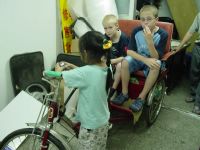 Bike to work!
Bike to work! Scene from the West End on a recycle a bicycle event hosted by Citiparks in the past.
Scene from the West End on a recycle a bicycle event hosted by Citiparks in the past.May 15–19 is Bike to Work Week!
Help get the word out about these fun events intended to network, grow, and promote the Pittsburgh bicycling community!
Monday, May 15 – Biker Breakfasts from 7:30 – 9:30 a.m.
* Whole Foods, East Liberty
* City-County building, downtown
* Carnegie Library in Oakland
Tuesday, May 16 – City Council proclamation will acknowledge Bike to Work Week
Wednesday, May 17 – Bike Breakfast at Carnegie Mellon (8am outside of the University Center)
Wednesday, May 17 – Commuter Clinic
* Bike Pittsburgh Executive Director Scott Bricker will offer tips on getting to and from work on two wheels, 7 p.m. at REI on the South Side
Friday, May 19 – End of the week party at the Brillobox (Corner of Penn and Main in Bloomfield). Come out and meet fellow Pittsburgh bike commuters and Bike Pittsburgh – the folks working to make the city better for bicycling. Members get 1 free drink!
Learn more about Bike Pittsburgh at www.bike-pgh.org. We’re working hard to make biking to work, shopping, and exercising by bike safe and fun for everyone in Pittsburgh!
Bike to Work Week is part of Great Outdoors Week which includes Venture Outdoors Festival (May 20th on the North Shore between the stadiums) and Pedal Pittsburgh (May 21 at Station Square Amphitheater.
Encourage others to bike to work.
Offer to meet a coworker somewhere along the way —- such as the Eliza Furnace Trail or Highland Ave. -— so you can ride to work together.
Make the most of MapHub and ByCycle or get involved with a BikePool to find routes and fellow riders.
Host your own biker breakfast! Bring coffee and bagels to share with your coworkers who ride in. You’ll be very popular.
Talk to your employer about installing bike racks, lockers, and even showers to encourage more people to opt to ride instead of drive to work.
Looking for more information? Please feel free to contact info -at- bike-pgh.org.
Bicycle vs. car facts:
According to a survey conducted by the Federal Highway Administration, 40 percent of all trips are within two miles of the home, and 50 percent of the working population commutes five miles or less to work. Yet more than 82 percent of trips five miles or less are made by personal motor vehicle.
Cycling at least 20 miles a week cuts in half your risk of heart disease compared to non-cyclists who take no exercise, according to the British Heart Foundation. The British Medical Association also recommends that you cycle daily.Grant and Erik sit in the back seat of a bike in a bike shop -- before we purchase it. Photo from May, 2005, when we were in Chengdu, Southwestern China. We rode that bike all around that city for four weeks. We'd go back to various bike shops, on a near daily basis to get various fixes and adjustments. It was like a fine-tuned sports car.
A month later, as we were about to depart China, Erik and Grant got to wheeling and dealing with a crowd of bike "experts" and "prospective buyers." The bike was "for sale" and the boys were trying to make a bargain with some locals. None spoke English.
The model American male devotes more than 1,600 hours a year to his car. He sits in it while it goes and while it stands idling. He parks it and searches for it. He earns the money to put down on it and to meet the monthly installments. He works to pay for gasoline, tolls, insurance, taxes, and tickets. He spends four of his sixteen waking hours on the road or gathering his resources for it. And this figure does not take into account the time consumed by other activities dictated by transport: time spent in hospitals, traffic courts, and garages; time spent watching automobile commercials or attending consumer education meetings to improve the quality of the next buy. - Ivan Illich, Energy and Equity
The bicycle also uses little space. Eighteen bikes can be parked in the place of one car, thirty of them can move along in the space devoured by a single automobile. It takes three lanes of a given size to move 40,000 people across a bridge in one hour by using automated trains, four to move them on buses, twelve to move them in their cars, and only two lanes for them to pedal across on bicycles. Of all these vehicles, only the bicycle really allows people to go from door to door without walking. The cyclist can reach new destinations of his choice without his tool creating new locations from which he is barred. -Ivan Illich, Energy and Equity

Erik and I at Ohio Pyle -- on a rest stop -- for That Dam Ride, a 2-day 140 mile trip. Photo from September 2005.





No comments:
Post a Comment